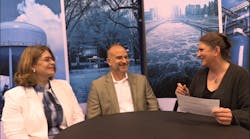Biosolids stabilization with lime or alkaline chemicals can be a low-cost method of producing Class A or Class B biosolids.
Stabilization can be accomplished in a variety of ways. The most common Class B processes are aerobic digestion, anaerobic digestion, and alkaline stabilization. These methods can be used as part of new systems or as add-ons to existing municipal wastewater treatment plants to achieve Class B biosolids treatment levels. Class A biosolids stabilization processes are lime stabilization, aerated static pile composting and thermal drying.
Alkaline stabilization is the least expensive of the three Class B methods mentioned, with an incremental unit cost of approximately $10-30 per dry ton of solids treated for a 5 dry ton per day capacity. The method also has the lowest capital costs - about 25 percent that of the other two digestion alternatives.
Alkaline stabilization requires less space than the other Class B alternatives, but increases the volume of treated biosolids. However, the lime method offers municipalities more flexibility to increase capacity or degree of treatment, i.e., it can achieve "Class A" treatment levels with little or no additional capital investment over that required for "Class B" operation.
Typical unit costs for Class A lime stabilization ($228/dry ton) are significantly lower than for aerated static pile composting ($277/dry ton) and thermal drying ($372/dry ton) for a 20 mgd wastewater treatment facility.
Federal Biosolids Regulations
Biosolids beneficial use/disposal practices are regulated under both federal and state statutes. The U.S. Environmental Protection Agencys (EPA) regulations are in Chapter 40, Part 503 of the U.S. Code of Federal Regulations. These regulations address the beneficial use and disposal of domestic sewage biosolids for land application (including biosolids distribution and marketing, and agricultural land application), surface disposal (including dedicated land application and monofilling), and incineration.
Federal Biosolids Regulations
As a means to classify the pathogen content of biosolids, the Part 503 regulations establish two classes - Class A and B. These classes specify performance goals and the degree of treatment biosolids must receive before beneficial use or disposal. Class A biosolids contain extremely low pathogen concentrations and have few or no use restrictions. Class B biosolids contain higher pathogen concentrations than Class A, but have levels low enough for some beneficial uses, such as land application with restrictions.
Federal Biosolids Regulations
In addition to regulating pathogen concentrations, the Part 503 regulations include requirements for reducing the tendency of biosolids to attract disease vectors such as rodents and insects. This type of problem may be alleviated in 11 ways. Four of these methods involve various forms of treatment of the biosolids.
The Alkaline Stabilization Process
Solids stabilization is important to the reliable performance of any wastewater treatment plant (WWTP). A successful program will reduce odors, pathogens, and putrescibility of the solids. In the process, raw wastewater solids are converted to a stable product compatible with the chosen beneficial use/disposal method at the least possible cost.
The Alkaline Stabilization Process
Post-lime stabilization involves the addition of dry quicklime to dewatered solids cake, a method in use since the 60s. The lime typically is mixed with the cake using a pug mill, plow blender, paddle mixer, or similar device.
The Alkaline Stabilization Process
Quicklime is usually less expensive than hydrated lime and easier to handle. Also, the heat of hydrolysis released in slaking the quicklime when it is added to dewatered cake can destroy more pathogens and reduce water content.
The Alkaline Stabilization Process
With lime stabilization, the operator can tailor operations to the quantity of sludge and the degree of treatment desired. To meet Class B requirements using lime stabilization, the pH of the biosolids must be elevated to more than 12 for two hours and subsequently be maintained at more than 11.5 for 22 hours.
The Alkaline Stabilization Process
To meet Class A requirements, the Class B elevated pH requirements are combined with elevated temperatures (70 degrees C for 30 minutes) or other EPA-approved time/temperature processes.
The Alkaline Stabilization Process
Also, to meet vector attraction reduction requirements, the pH must be raised to 12 or higher for two hours and then maintained above pH 11.5 for another 22 hours without further alkali addition.
The Alkaline Stabilization Process
A number of Class A lime stabilization technologies use higher lime doses and other alkaline additives in addition to or instead of lime or involve special equipment or processing steps. In general, lime stabilization is a non-proprietary process.
The Alkaline Stabilization Process
New methods of alkaline stabilization using materials other than lime recently have been developed and are being used by municipalities. Most of these technologies that rely on additives such as cement kiln dust (CKD) or fly ash are modifications of traditional dry lime stabilization. The most common modifications include the addition of other chemicals, a higher chemical dose, and supplemental drying. These processes are intended to alter the characteristics of the sludge and, depending on the process, increase the stability, decrease the odor potential, reduce pathogens, and provide end product enhancement.


